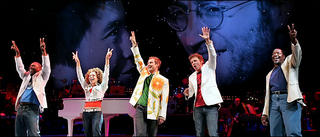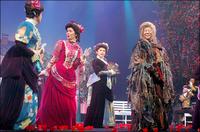William Niederkorn: Shakespeare Denier
Readers of this blog will not be surprised to see me criticize the New York Times' coverage of the arts. However, my proverbial "goat" is never "gotten" so greatly as when they run a piece by a certain William Niederkorn. Who is William Niederkorn, you may ask, and why do I only see his byline next to articles questioning Shakespeare's authorship?
At the bottom of his surprise appearance on today's Books page (one never knows where or when the Times is going to unleash him) we finally get some identification: "William S. Niederkorn, a playwright and composer, is an editor in the culture department of The New York Times." Well, we knew he wasn't a journalist, at least. That much has been obvious. As a Times search will reveal, since 2000 Niederkorn has popped up 11 times in the Arts section always, exclusively, in oddly slanted pieces claiming some huge breakthrough in exposing the "fraud" that is Shakespeare. (Even a 6/20/2002 article reporting the withdrawal of an already questionable poem from the canon supposedly "opened up" larger questions.) I say "odd" because when you read Niederkorn, it is immediately apparent that the articles treat the "question" as "open" from the beginning. Is it the New York Times policy not to take the existence of Shakespeare for granted?
Niederkorn isn't just a reporter covering an intellectual sideshow. He has a dog in the fight himself--he is a committed "Oxfordian," that is one who backs the "candidacy" of Edward de Vere the Earl of Oxford who--inconveniently--died in 1604, and whose only legacy of attributed writings so far consists of some pretty lame verses. He beats the de Vere drum in every single article so clearly--referring to fringe books and websites--going on and on about this obscure Earl like no other reporter. In the world of Niederkorn, people foolish enough to buy the Shakespeare line are just "Stratfordians" (as if it's the city we worship!) making life difficult for his Oxfordians. As Stephen Greenblatt has said, imagine the Times reporting on a debate between Ptolemaics and "Copernicans" when it comes to the solar system. It is all clearly a personal cause, especially when you realize this is all the man ever writes about! (Meanwhile, what kind of "cultural editing" is he really doing over there? I'm tempted to ask: whose nephew is the guy?)
Mind you, all these articles have appeared under the guise of objective arts reporting. (None have been an op-ed, for instance.) At least the Times has the sense to finally label today's piece an "Essay," whatever that means. So what is today's excuse for Niederkorn's soap box? Actually it's a book review of sorts, taking advantage of the release of a few Shakespeare-related books lately, some by actual professors (Stephen Greenblatt's Will in the World, James Shapiro's 1599) and some...well, not (Shakespeare by Another Name, a de Vere biography by a supporter). To give Niederkorn credit, he does find something to criticize in the de Vere book, but only when he finds his logic as weak as that of the "traditionalists"! Thank god for a strawman like Clare Asquith's Shadowplay, which attempts to defend Shakespeare's name by use of "codes" in the plays. This gives Niederkorn his sneering title: "The Shakespeare Code, and Other Fanciful Ideas From the Traditionalist Camp." I wonder how many Times readers were surprised to wake up this morning to learn there was a "traditionalist camp"--and that they themselves probably had belonged to such a sorry thing all these years.
Here's some typical Niederkorn (again, seemingly endorsed by the New York Times):
The traditional theory that Shakespeare was Shakespeare has the passive to active acceptance of the vast majority of English professors and scholars, but it also has had its skeptics, including major authors, independent scholars, lawyers, Supreme Court justices, academics and even prominent Shakespearean actors. Those who see a likelihood that someone other than Shakespeare wrote the plays and poems attributed to him have grown from a handful to a thriving community with its own publications, organizations, lively online discussion groups and annual conferences.Sounds legit, eh? (Niederkorn himself has spoken at at least one of the Oxfordian conferences.) Then you realize "major authors," probably refers to mystery novelists more than Elizabethan historians; "independent scholars" by definition are those without teaching positions, or usually degrees; "lawyers"--ahem. As for the "prominent Shakespearean actors," well I do admire Derek Jacobi's performances, but has he done the research? (Another "prominent" actor mentioned on the Oxfordian website is Keanu Reeves.)
You know, Holocaust deniers have "conferences," too. Not to mention "lively online discussion groups"...
I understand why some might enjoy Shakespeare authorship fantasies as a kind of parlor game. But there's a good reason no tenured professor gives them any credence. And no, it's not world conspiracy and Masonic domination. It's that there's really nothing wrong with the accepted Shakespearean biographical record, slim as it is. Not enough wrong, at least, to disprove the all the evidence that keeps telling us this is the man who wrote the plays that bear his name. I will be happy to argue this in full some other time, at length. For now, I refer you to Brian Vickers' excellent rebuttal in the TLS recently--which Niederkorn (derisively) references himself.
(And I do believe such rebuttals are now necessary. For years, Shakespeare scholars have made the mistake of "not dignifying" the "pretenders." But now--just like evolutionary biologists--they could lose the debate in the mass media, which rewards controversy for conrtoversy's sake and always rewards the loudest. My advice to Stephen Greenblatt and Stephen Jay Gould--were he alive--alike: play offense, not defense. Remind everyone that the fringe arguments are more full of holes than even the "traditional theories.")
Look: no matter where you stand or how much of this you want to take seriously, anti-Shakespeare activism is--by definition--a fringe theory. Why does the New York Times, who falls at the feet of famous professors any chance they get, think it's okay to dis such a titan as Stephen Greenblatt on just this particular issue? (Niederkorn's articles are notoriously short on giving the "traditional" side its say.) Isn't anyone there embarrassed to lend legitimacy--with the great, Grey Lady's ink--to something no one in the academy respects? Funny that they only just completed a huge series devoted to "Intelligent Design." I'd say "Oxfordian Design" carries about just as much weight in academic circles. (Now if the Times has decided to turn against the academy, that would be news...)
Niederkorn tries to end on a "reasonable" note, which points out the flaws in both sides. (How "equal time."):
On both sides of the authorship controversy, the arguments are conjectural. Each case rests on a story, and not on hard evidence. Either side, or both, might eventually be proved wrong.Yeah, we're all just guessing. Forget that we have tons of scraps of paper (including--ahem--the First Folio) saying poor little Will wrote the plays--and none identifying anyone else. Forget the wealth of evidence we do have about Shakespeare's life (see Schoenbaum's Shakespeare: A Documentary Life), even if it does not satisfy romantic gossipmongers like the Oxfordians.
But who in the general readership has time to pay attention to such... facts. And sowing the seeds of doubt--in the pages of the nation's most important cultural newspaper, I don't mind repeating--is exactly Niederkorn's goal. He closes:
Meanwhile, and it could be a very long meanwhile, perhaps an eternal meanwhile, things will continue as they are. Or perhaps not. What if authorship studies were made part of the standard Shakespeare curriculum?Hmm, "teach the controversy." Where have we heard that before? It is my nightmare that the most susceptible to these conspiracy theories will be high school English teachers, desperate to "spice up" their Shakespeare curriculum for their IPod-coma-induced charges. We must all be on the lookout for this in our already impoverished educational system.
Here is another fisking of a previous Niederkorn appearance, by Irvin Leigh Matus. Matus, a pro-Shakespeare independent scholar has put together a fine site, Willy Shakes. Ditto David Kathman and Terry Ross's Shakespeare Authorship Page. If Niederkorn's article still leaves you with nagging doubts about Shakespeare, these sites do an excellent job dispelling the myths, and exposing the dissenters.










